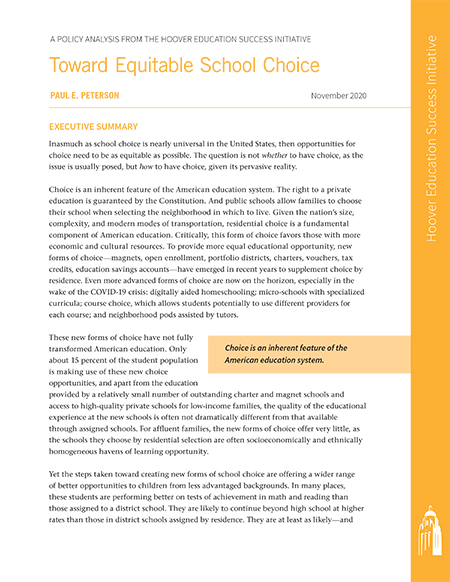The fourth education policy brief to be released by the Hoover Education Success Initiative in 2020, it comprehensively examines the past, present and future of school choice at the federal, state, and local levels, making recommendations on how state governments should proceed amidst uncertainty.
STANFORD, CA – With a nominee for Secretary of Education expected soon, and with governors and legislators developing their 2021 policy agendas around the country, the Hoover Education Success Initiative (HESI), an education policy research initiative at Stanford University’s Hoover Institution, has released “Toward Equitable School Choice”, an evidence-based policy paper includes both a summary of research findings and a set of practical recommendations for state and federal policymakers’ consideration and usage.
The paper outlines the ways in which school choice, or lack thereof, is an inherent feature of the American education system. To provide more educational opportunity, new forms of choice—magnets, open enrollment, portfolio districts, charters, vouchers, tax credits, education savings accounts—have emerged in recent years to supplement choice, or lack of choice, created by residence. In the wake of the COVID-19 crisis this now includes digitally aided homeschooling, micro-schools with specialized curricula, course choice which allows students to use different providers for each course, and neighborhood pods assisted by tutors.
The paper also outlines the steps already taken toward creating new forms of school choice to a wider audience of children from less advantaged backgrounds—and highlights how the demand for more choice opportunities exceeds the supply of choice schools available. It also provides evidence that choice schools do not have a negative impact on the performance of students at assigned schools, and that they have little impact on the degree of ethnic segregation in the United States—nor do choice schools have a negative fiscal impact on the per-pupil expenditure levels of assigned district schools. It notes that while more equitable forms of choice should not be expected to fully replace residential choice, their popularity among parents and students will likely increase. The paper includes six guiding principles for policymakers looking forward.
This policy paper was informed by four distinct background research papers crafted for HESI by Robin Lake, Anna Egalite, Tomas Monarrez & Matthew Chingos, and Patrick Wolf.
“Over the last few decades, school choice has become nearly universal in American life, and the events of 2020 have only accelerated this fact,” said Paul Peterson, author of the briefing. “We now have piles of scientific research on the various forms of school choice, most of which send positive signals about its role and importance—so the next decade should be about how to make these various forms of school choice more equitable and available to all.”
“In talking to thousands of families across multiple geographies over the past decade, I’ve rarely met a student or parent that did not want more high-quality school, course, learning, and advancement options,” said Christopher N. Ruszkowski, executive director of HESI and former state education secretary for the State of New Mexico. “What this latest HESI paper provides is a comprehensive research survey across the the major forms of school choice in America, which will be useful to state commissioners legislatures as they look to 2021 and beyond.”
About the Hoover Education Success Initiative
With passage in 2015 of the Every Student Succeeds Act (ESSA), states were again placed clearly in charge of American education policy. To support them in this undertaking, the Hoover Education Success Initiative (HESI), launched in 2019, seeks to provide state education leaders with policy recommendations that are based upon sound research and analysis.
HESI hosts workshops and policy symposia on high-impact areas related to the improvement and reinvention of the US education system. The findings and recommendations in each area are outlined in concise topical papers.
The leadership team at HESI engages with its Practitioner Council, formed of national policy leaders and interested state government leaders. HESI’s goal is to spark innovation and contribute to the ongoing transformation of the nation’s K-12 education landscape, thus improving outcomes for our nation’s children.


























